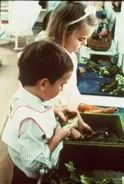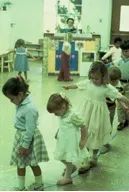BLOG: Introducing Practical Life for Parents
Introducing Practical Life for Parents
By Karen Lorance, Guest blogger for Age of Montessori
“To be or not to be”—perhaps that is the question posed of the soul of each child upon entry into this world of ours. As adults, of course, we desire our children to be. We want them to achieve and to aspire to the greatness that only they can become. We understand that we are individuals coursing through this world to make it great, each in our own time and in our own way. The Montessori classroom was made for this task—this mission.
Becoming oriented to this world of ours where he can gain a conscious, cohesive and purposeful involvement in everyday life is a humble, albeit immediate, need of every young child. To achieve this, the child needs direct contact with real-life physical objects and activities to which his mind can connect: practical life experiences with practical life materials.
The mind allowed to function without this help is left bereft of understanding and relevancy if it cannot connect its awareness to concrete, manipulative materials. He desires it; he expects it; he almost wills it to happen. Dr. Elisabeth Caspari, a beloved student of Maria Montessori, once stated that this “mind in the making” needs to be fed just as the child’s body needs to be fed. The child thrives on order, rhythm and ritual.
How can we help?
So what can we do to fulfill these very basic needs in the child? As parents and as educators the answer is the same. What we need are materials; practical, useful materials for the child to manipulate. We need lessons to refine the child’s movement and order to keep the child functioning in a secure harmony with his surroundings and environment.
In our homes, we carry out our lives in a very practical manner. We have tools to make our work easier and we establish rituals to ensure order. We have schedules, we have bathroom and kitchen utensils to help us care for ourselves and our homes; we have implements for cleaning, gardening as well as instruments for communicating and doing our jobs. As adults, using our tools and becoming acclimated to our daily, weekly and monthly rituals becomes second nature. We like things to flow smoothly and, for the most part, they do if we surround ourselves with order.
The small child especially needs these tools, as well, yet he depends on us to supply his every need and want. We must safeguard his stability, security and his eventual growth by providing him with the instruments he needs to further his own development and to participate in our family living. With the proper tools we can help make our child’s transitions to new and broadening horizons as easy as possible. The desires within the child must be met with all the necessary apparatus and materials to satisfy these desires. We, as responsive parents and adults, must observe and understand just what it is our child needs for these transitions.
Help me to do it myself!
When we think about the process of the child’s increasing mastery and as we observe our children, we understand how very simply these desires can be met. We do for the small child those things which he cannot do for himself until, gradually, one task at a time; we transfer responsibility to him for his own doing and achieving. “Help me to do it myself!” is the battle cry of that little child. The transfer is quite a long process that comes in increments over many years. Montessori tells us that everything that we do for the child that he can do for himself is an obstacle to his development. That bears thinking about!
Practical life at home and at school
Practical life lessons both at home and at school are shown to each child with slow and deliberate movement. What we take for granted is new to the child. Each intricate step must be clear in his mind so he can assimilate it and respond. He is absorbing each detail as he sees it. Lessons are given in a gradual order and sequence as the child is ready to receive them.
In perhaps the very first steps of Practical Life lessons in the Montessori Primary classroom, the child learns the graceful art of pouring. He must learn how to control his movements. He begins with pouring grains or beads or beans from one small container or pitcher to another. Then as he masters his motions, he steps up to pouring liquids from one pitcher to another. He eventually graduates to squeezing juice and pouring tea for his friends at a table! These are surely things that can and do happen at home if you set things up and invite the child to do them.
 What begins as washing a table can graduate to washing, rinsing, drying and putting away dishes from a classroom snack or lunch. What begins with the grating of soap to make soap bubbles can culminate in grating and cutting fruits and vegetables for a colorful snack or delicious soup. These are everyday exercises in Practical Life.
What begins as washing a table can graduate to washing, rinsing, drying and putting away dishes from a classroom snack or lunch. What begins with the grating of soap to make soap bubbles can culminate in grating and cutting fruits and vegetables for a colorful snack or delicious soup. These are everyday exercises in Practical Life.

Check our December Heart of Montessori newsletter for some great tips on including practical life during your family’s holidays!


There is a passion among young children to learn how to walk on an elliptical line with their fellow classmates to all sorts of rhythms and movements, and to walk on the lines of the sidewalk or the edge of a curb on a safe street. These simple actions can mean grace and courtesy as the child walks around his home, his neighborhood and his city.
So in the properly prepared environment of the early childhood Montessori classroom, the Directress lovingly sets out to organize and stock the Practical Life exercises. In Montessori homes and schools today, we find the basic activities that children throughout the world over the past hundred years have gravitated to and used time and time again. Children never tire of doing the exercises they need to do to fulfill that inner drive to gain mastery and self assurance in the world. The young child is most eager to begin his exploration of all the Practical Life lessons displayed before him.
Some of the Practical Life lessons may seem, at first, to be dated and perhaps a bit old fashioned (for example, the washboard), but we discover that these are some of the very lessons so necessary to prepare the child for his advancement into the finer motor skills he will need later on for writing and mathematics.

Sweeping floors, dusting shelves, folding clothes and washing tables are exciting and noble exercises for the young child. Remember, we are looking at the world and its environment from the child’s eyes. These perceptive eyes are quite different from our own adult eyes.
So it is “the more the merrier” in the engagement of the child’s focus on Practical Life. Allowing the child the freedom to explore and choose each lesson as she is given instructions to use and to repeat it again and again at will is indeed strengthening and fulfilling. Our job is to show the child how to do the activity. It is her choice to repeat it when it corresponds to developmental impulses. In our Montessori classroom, we offer many activities to each child, but do not insist that the child do them at any given time.
When the child works, she is being directed as if by an invisible but powerful force, the sensitive periods of her own development. Learning to take care of and having respect for self, others and her world are the building blocks for self esteem and sense of self worth.
Give the child practical and sensible work and he will be satisfied to step beyond this period of strong sensibilities to the future of abstract thinking and imagining. Practical Life exercises in movement and grace anchor these internal desires into positive, ordered mental and emotional memories. They round out the child’s rough edges through work and interactions with the community of his classroom.
He desires, he discovers, he builds, and he conquers. He becomes our future leader with a strong commitment to integrity and completion. In a concerted effort, parents, child and teacher work hand in hand. We look forward to the task. We work together to serve the little child in us all—practically and responsibly.
Karen Lorance is the mother of six Montessori children. She helped out in most of their classrooms over a span of more than twenty years and is now a student at Age of Montessori’s teacher training program.




















